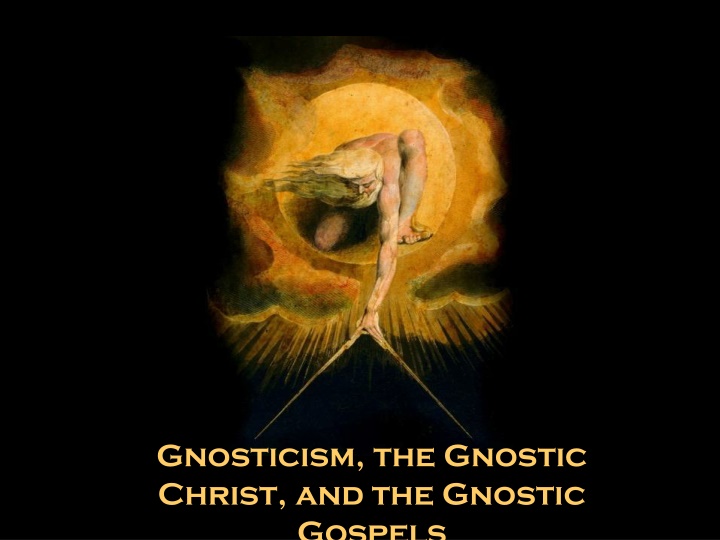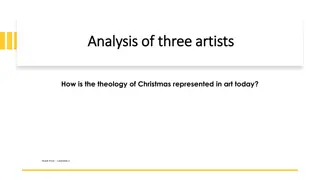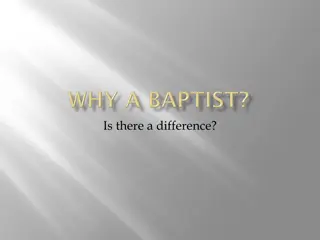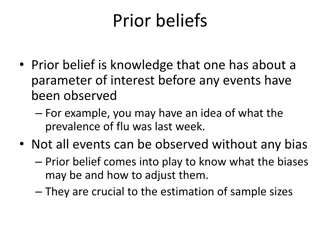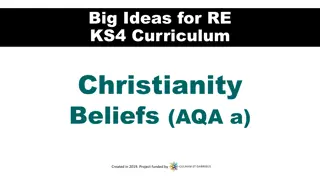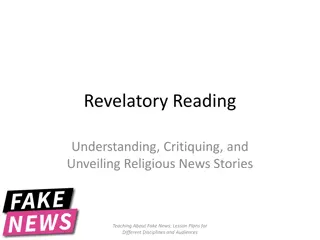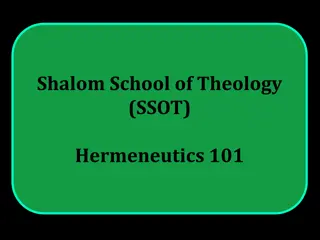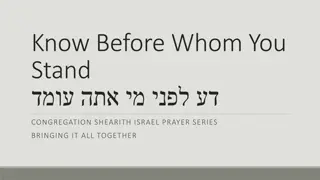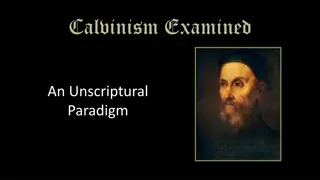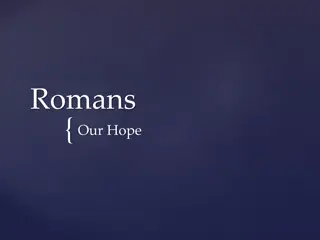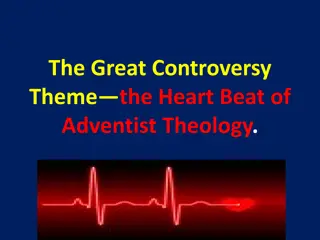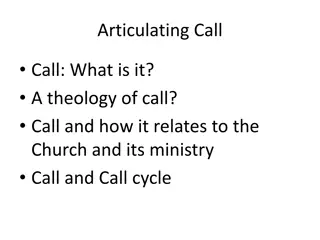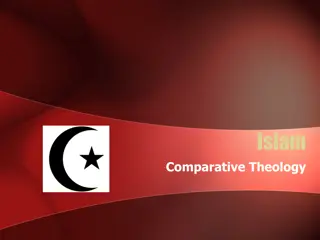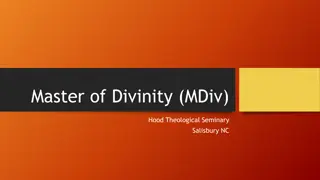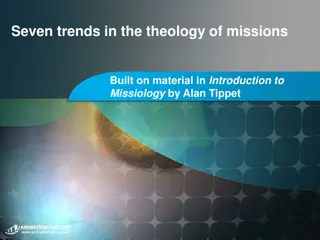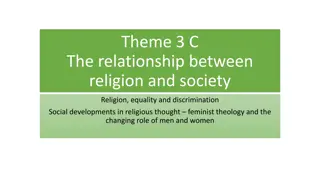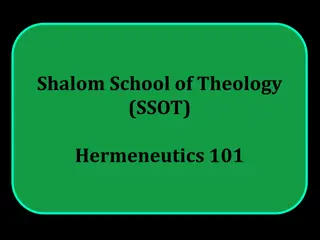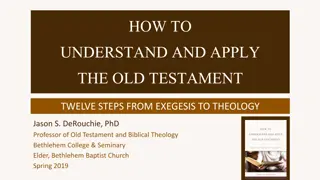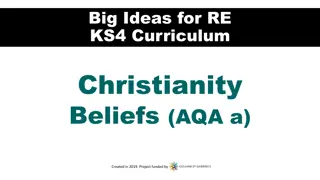Unveiling Gnostic Beliefs and Theology
Uncover the teachings of Gnosticism, exploring its unique perspective on spirituality and the divine. Delve into Gnostic cosmology and theology, challenging conventional views on creation and existence. Discover the Gnostic interpretation of the world's imperfections, salvation, and the relationship between humans and the creator.
Download Presentation

Please find below an Image/Link to download the presentation.
The content on the website is provided AS IS for your information and personal use only. It may not be sold, licensed, or shared on other websites without obtaining consent from the author.If you encounter any issues during the download, it is possible that the publisher has removed the file from their server.
You are allowed to download the files provided on this website for personal or commercial use, subject to the condition that they are used lawfully. All files are the property of their respective owners.
The content on the website is provided AS IS for your information and personal use only. It may not be sold, licensed, or shared on other websites without obtaining consent from the author.
E N D
Presentation Transcript
Gnosticism, the Gnostic Christ, and the Gnostic Gospels
Preliminary Summary What does Gnosticism seek to provide? What spiritual help does it offer? www.gnosis.org
Preliminary Summary Gnosticism is the teaching based on gnosis, the knowledge of transcendence arrived at by way of interior, intuitive means. Knowing God (this transcendent One) is not achieved by external revelation The means is internal Therefore requires an awakening
Preliminary Summary Suggests that there is something we don t know that needs to be known. That something is Gnosticism s story, the realization of which is what produces salvation.
Preliminary Summary Gnosticism fundamentally recognizes: Earthly life is filled with suffering. All forms of life consume each other, thereby visiting pain, fear, and death upon one another. Natural catastrophes bring further suffering and death in their wake. Something isn t right about the world
Preliminary Summary Many religions advocate that humans are to be blamed for the imperfections of the world. The Fall of humanity Judaism Orthodox Christianity Gnosticism rejects this idea.
Preliminary Summary Gnosticism argues that blame for the world s failings lies not with humans, but with the creator. Since -- especially in the monotheistic religions -- the creator is God, this Gnostic position appears blasphemous.
GNOSTIC COSMOLOGY & THEOLOGY
The (Ultimate) Beginning True God A pre-existent, uncaused, perfect being; the Light
The (Ultimate) Beginning True God male/female aspects These aspects (father/mother) bring forth many emanations
The (Ultimate) Beginning True God emanations
The (Ultimate) Beginning True God emanations aka = AEONS
The (Ultimate) Beginning True God AEONS = PLEROMA
The (Ultimate) Beginning True God The created universe / material world we know Doesn t exist at this point
The (Ultimate) Beginning True God SOPHIA
Observations View we just saw feels DUALISTIC Some Gnostics (Valentinians) taught that this creation of our material world by the Demiurge was an illusion deriving from our own misperceptions of the true God Only reality = what derives from the true God (= MONISM)
Salvation? The Christos comes to earth, manifest as a man (or resting upon a man = Jesus) to reveal the Light and Gnosis. The Demiurge s archons / powers of darkness manipulate humans to kill Jesus. The Christos returns to the Light / Pleroma. His message = gnosis; light vs. darkness
Summary Gnostics believe: The true God and the divine Creator of our world are different beings. Evil and suffering are the fault of this Creator (the Demiurge) Humanity was created, but has a spark of the true God via Sophia
Summary Salvation for humans is not deliverance from sin, but being awakened about their true divine nature. Human destiny = return to the light Return to the true source of human consciousness Journey back into the cosmos
Manuscripts of the New Testament vs. The Gnostic Gospels from Nag Hammadi
Leigh Teabing, Grail expert character in The DaVinci Code: More than eighty gospels were considered for the New Testament, and yet only a relative few were chosen for inclusion Matthew, Mark, Luke, and John among them. (p. 231) These texts . . . are the earliest Christian records (245) and the unaltered gospels (248).
What are the Nag Hammadi Documents? The Nag Hammadi texts are a collection of thirteen ancient codices containing over fifty Gnostic texts. They were discovered by accident in upper Egypt in 1945.
The books were quickly sold on the black market but were soon obtained by the Egyptian government. They were taken to the Coptic Museum in Cairo, and another few years went by before scientists were made aware of their existence
In 1966 at a conference in Italy devoted to Gnosticism and these new texts, James M. Robinson assembled a group of editors and translators to publish the Nag Hammadi codices in English, in collaboration with the Institute for Antiquity and Christianity in Claremont, California. Robinson oversaw the project. In the meantime, a facsimile edition in twelve volumes did appear between 1972 and 1977, with subsequent additions in 1979 and 1984 from publisher E.J. Brill in Leiden. The James M. Robinson translation was first published in 1977, with the name The Nag Hammadi Library in English.
The introductory material prefacing this translation notes: The library of fourth-century papyrus manuscripts consists of twelve codices plus eight leaves from a thirteenth and contains fifty-two separate tractates. Due to duplications there are forty-five separate titles. Because the majority of the library s tractates derive from the Hellenistic sects now called gnostic, and survive in Coptic translations, it is characterized as the Coptic Gnostic Library. (p. ix)
Do we have any other hard evidence that the New Testament Gospels are older than the oldest Nag Hammadi material? What about the entire New Testament? Is that older than the oldest Nag Hammadi material?
Presumed Greek original Gnostic gospels NT Gospels, Acts Coptic Gnostic Gospels (Nag Hammadi) 33 AD 325 NICEA 50 80 100 200 300 400 500 Why 50-80 AD for the New Testament Canonical Gospels? What is the Evidence? Three Non-technical Points for Today: 1. The gospels prophesy the destruction of the Temple (occurred in AD 70) but never mention its fulfillment. Matthew 24, Mark 13, Luke 21 2. Luke never mentions the death of Paul and Peter in either his gospel or its sequel, the Book of Acts
Presumed Greek original Gnostic gospels Coptic Gnostic Gospels (Nag Hammadi) NT Gospels, Acts 33 AD 325 NICEA 50 80 100 200 300 400 500 Didache (70- 130) quotes Matthew extensively Luke and John are both quoted in the Muratorian Fragment / Canon (170- 180 AD) Epistle of Pseudo- Barnabas (70-79) quotes Gospels of Matthew and Mark Polycarp (69-155), a convert of the apostle John, quotes the book of Acts in his own Epistle to the Philippians (1:2); The Shepherd of Hermas (100-160) quotes Acts several times. The Four NT Gospels and the Book of Acts
Presumed Greek original Gnostic gospels Coptic Gnostic Gospels (Nag Hammadi) NT Gospels 33 AD 325 NICEA 50 80 100 200 300 400 500 1 Corinthians is cited in the Didache and the Shepherd of Hermas (100- 160) Romans is cited by Clement of Rome (95-97), Polycarp (69- 155), and the Didache (70- 130) Galatians is cited by Polycarp, Diognetus Ephesians and Colossians are cited by Polycarp, Clement, & Ignatius (50-117) 2 Corinthians is cited by Polycarp, the Shepherd of Hermas, and the Epistle of Diognetus (150) Philippians is cited by Polycarp, Shepherd of Hermas, and Ignatius The Epistles of Paul Part 1
Presumed Greek original Gnostic gospels Coptic Gnostic Gospels (Nag Hammadi) NT Gospels 33 AD 325 NICEA 50 80 100 200 300 400 500 1 Timothy and Titus are cited repeatedly by Clement; also cited in the Didache (1 Timothy) and the Shpeherd 1 and 2 Thessalonians is cited in the Shepherd of Hermas, the Didache, Polycarp, and Ignatius Ignatius makes allusions to the personal letter to Philemon The Epistles of Paul Part 2
Presumed Greek original Gnostic gospels Coptic Gnostic Gospels (Nag Hammadi) NT Gospels 33 AD 325 NICEA 50 80 100 200 300 400 500 The book of Hebrews is cited frequently by Clement and also by the Didache. 1 John is cited in the Shepherd of Hermas 1 and 2 Peter are cited by Clement 2 John is cited by Polycarp and in the Muratorian Fragment (170-180); 3 John and Jude are also cited by the Muratorian Fragment James is also cited by Clement and Ignatius Revelation is cited in the Didache, Shepherd of Hermas, and by Justin Martyr (160) The General Epistles and Revelation
The fact is that the followers of Christ had chosen the 4 canonical Gospels as the true story of Jesus very early before any of the surviving texts of the Coptic Gnostic Gospels, and likely before the Gnostic Gospels were composed (with the possible exception of the Gospel of Thomas).
Presumed Greek original Gnostic gospels Coptic Gnostic Gospels (Nag Hammadi) NT Gospels 33 ADt 144 170 325 NICEA 50 80 100 200 300 400 500 160 John dies ca. 96 AD Justin Muratorian Fragment Tatian Marcion Describes 4 gospels, 13 epistles of Paul, Jude, 2 epistles of John Diatessaron Memoirs of the Apostles Harmony of Four the Gospel and the Apostle
A word on Tatians Diatessaron: Justin s disciple Tatian (c. 170 AD) produced a new edition of the fourfold Gospel by unstitching the sections of its four component parts and then rearranging them so as to form one continuous narrative. This edition, the Diatessaron( harmony of four ), proved very popular, especially in Tatian s native Assyria, where the Syriac- speaking church was most unwilling to abandon it at the beginning of the fifth century in favor of a new Syriac version of the four separate Gospels. [The Gospel of Thomas] has been dated as early as A.D. 50 70 and as late as the end of the second century (note the wide divergence of dating opinion). But since parallels to its more explicitly Gnostic concepts and terminology date from the second century, it is probably no older than the end of the first century. The attribution of the Gospel to Didymus Judas Thomas (prologue) shows that it derives from the East Syrian Christian tradition, centered on Edessa. NT Canon ; Gospel of Thomas, Dictionary of Jesus and the Gospels (IVP)
Jesus married? NH Texts Mary his wife? NH Texts
Jesus had a wife? NH Texts
